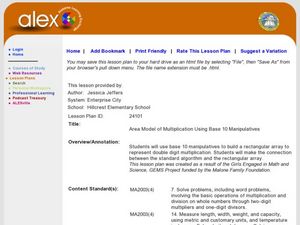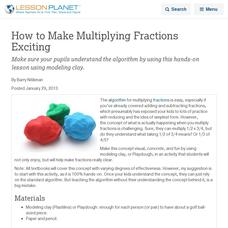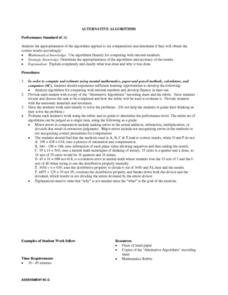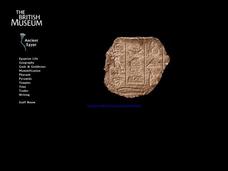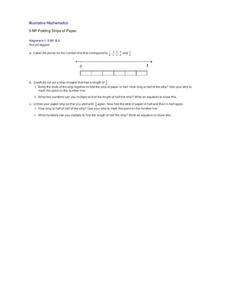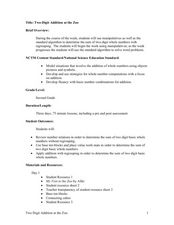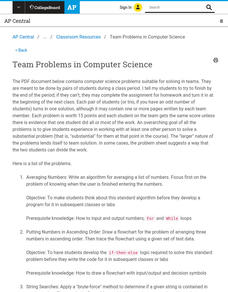EngageNY
Dividing Multi-Digit Numbers Using the Algorithm
Scholars learn to divide multi-digit numbers using the standard algorithm in the 14th installment in a module of 21 parts. They get plenty of practice with the algorithm by completing a worksheet.
Curated OER
Solving a Simple Maze
It is a-maze-ing how lost one can get. Teams reconstruct a simple maze and solve it. Participants create an algorithm that a robot would follow in order to solve the maze as well. The activity includes an extension directing pupils to...
EngageNY
The Division Algorithm—Converting Decimal Division into Whole Number Division Using Fractions
Knowing the standard algorithm opens up a whole new world of division. Scholars learn how to convert division involving decimals to division involving whole numbers to use the standard algorithm. Knowing how to multiply with powers of...
Curated OER
Area Model of Multiplication Using Base 10 Manipulatives
Explore two-digit multiplication with your class as they work in groups to build models of two-digit multiplication using base 10 manipulatives. They construct rectangles replacing standard numbers with equivalent place values using...
Curated OER
How to Make Multiplying Fractions Exciting
Make sure your pupils understand the algorithm by using this hands-on lesson using modeling clay.
Curated OER
Multiplying in Columns, Standard Way
In this multiplying and carrying worksheet, students compare the standard algorithm with the multiplying in parts method and their examples, choose which method to use, and find the products. Students solve twenty problems.
Curated OER
The Multiplier (origin of the algorithm)
Students explore basic algorithms for addition, subtraction, and multiplication. They use models to demonstrate solving two-digit by two-digit multiplication. Students demonstrate vertical formats to solve multiplication problems.
Shodor Education Foundation
Algorithm Discovery with Venn Diagrams
Here is a instructional activity that takes an interesting approach to analyzing data using box and whisker plots. By using an applet that dynamically generates Venn diagrams, the class forms a strategy/algorithm for guessing the...
Curated OER
Alternative Algorithms
Analyze algorithms for computing with rational numbers and develop fluency in their use with your math class. They work individually to solve the problems on the "Alternative Algorithms" sheet. Then, they analyze the appropriateness of...
Curated OER
Models and Algorithms to Solve Multiplication Problems
Young scholars choose the correct strategy to solve multiplication and division. In this algorithm lesson, students use at least two strategies that use properties of operations and estimation. Young scholars also recognize the...
Curated OER
Standard Equation of an Ellipse
In this ellipse worksheet, students explore given equations and write them in standard form. This one-page worksheet contains ten ellipse algorithms.
Scholastic
Study Jams! Addition with Regrouping
Zoe needs to back up her music collection, but do her friends have enough space on their computers to help? Find out as you teach your class how to add two- and three-digit numbers with regrouping. Place value is emphasized as both the...
EngageNY
Grade 5 Math Module 1, Topic D, Lesson 9
Introduces addition of decimals by using unit notation to represent the problem. Pupils use a place value chart to decompose the numbers and then add before connecting to the standard algorithm.
Illustrative Mathematics
Reasoning about Multiplication and Division and Place Value, Part 2
The learner puts reasoning and estimation to work. The directions are to place a decimal in the answer to make the equation true. Pupils are to look at the two problems, one multiplication and one division, and estimate an answer. No...
EngageNY
Rational and Irrational Numbers
Back to the basics: learning how to add numbers. The 17th installment of a 35-part module first reviews addition techniques for rational numbers, such as graphical methods (number line) and numerical methods (standard algorithm). It goes...
Curated OER
Folding strips of paper
Fifth graders need concrete experiences to introduce a unit on multiplying fractions by fractions. A strip of paper is used to create a number line and represent 5/6. It is folded first in half, and then in quarters. After unfolding,...
Curated OER
Partial Quotients
Fifth graders examine the partial-quotients algorithm for finding the answer to a division problem. For this partial quotients lesson, 5th graders demonstrate the process of division through a series of estimations....
Curated OER
Two-Digit Addition at the Zoo
Your second graders explore two digit addition with regrouping. They will investigate problem solving strategies within the context of a trip to the zoo. Multiple resources and assessments are provided.
College Board
Team Problems in Computer Science
There is no I in team. Seven team problems provide classmates the opportunity to work with a partner on a task. Projects span the course and require pupils to apply their knowledge. Tasks range from writing the algorithm in English to...
Curated OER
Divisor The Great! (Divide by Two-Digit Divisors)
Manipulatives make learning division easier! Your class will discover the difference between dividing with one- and two-digit divisors, and practice the procedures for each using the standard algorithm. They will use estimation to ensure...
Curated OER
Long Division 1 Homeschooling Haven
Long division without remainders is the name of the game in this resource. Students practice the standard algorithm as they solve problems that containing four- or five-digit dividends and three-digit divisors. There are actually six...
Gecko Mathematics
Gecko Mathematics: Multiplying Unit Fractions
Make learning visible! Have your mathematicians follow along as you use paper strips to demonstrate the concept of multiplying unit fractions. Then, offer a different way of solving the problem using a number line. Finally, introduce the...
PHET
Area Model Decimals
Area works with decimals too. Pupils use the interactive to model multiplication of two decimals using an area model. They see how the decomposed components of the factors obtain partial products and then the complete product. Using area...
EngageNY
Grade 5 Math Module 1, Topic F, Lesson 14
Be sure to place value on place value understanding. Young mathematicians learn to divide decimals by whole numbers when compatible numbers are not available. They use place value discs in place value charts, then connect this strategy...





